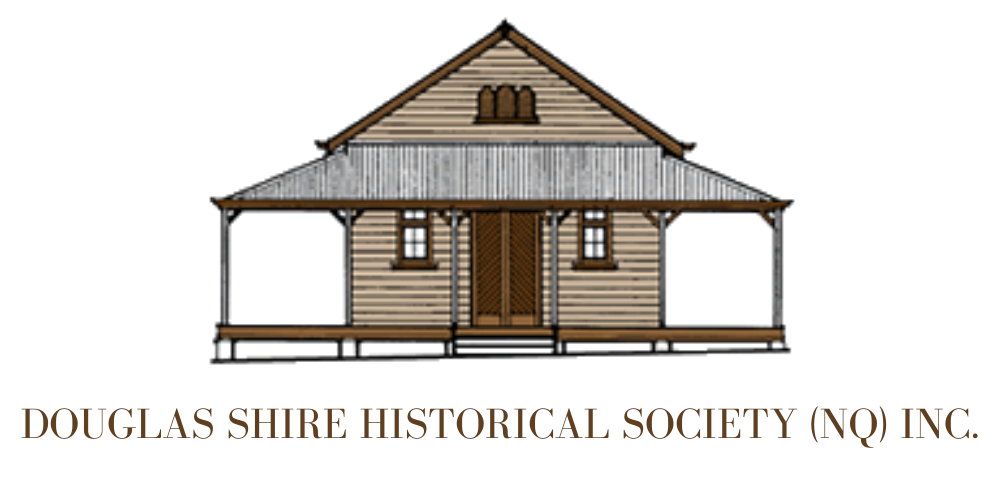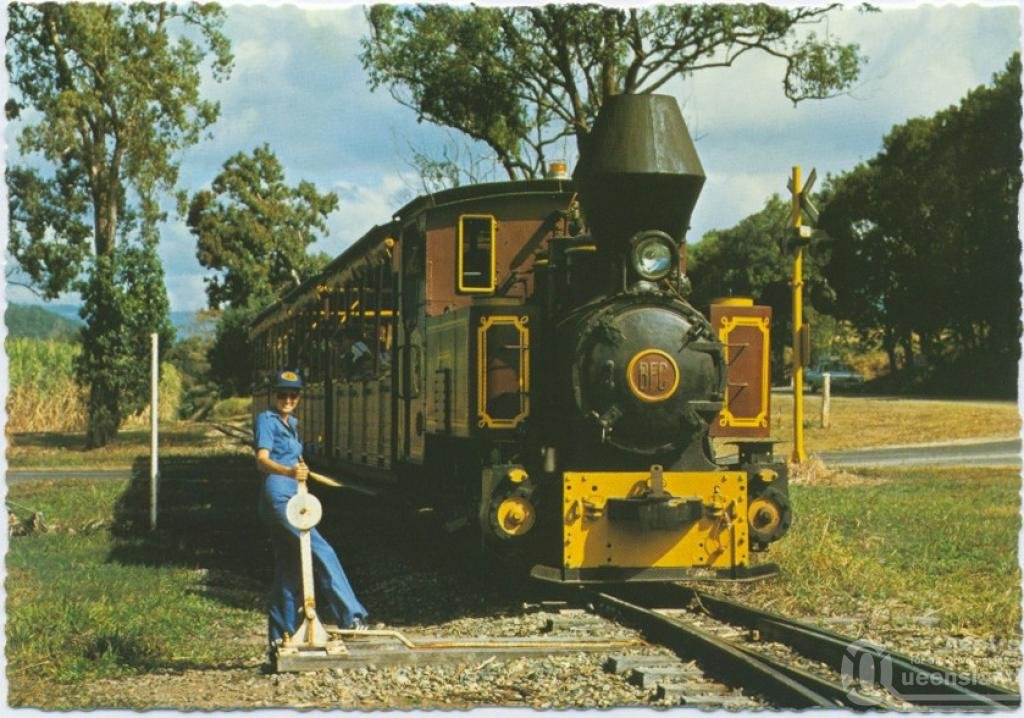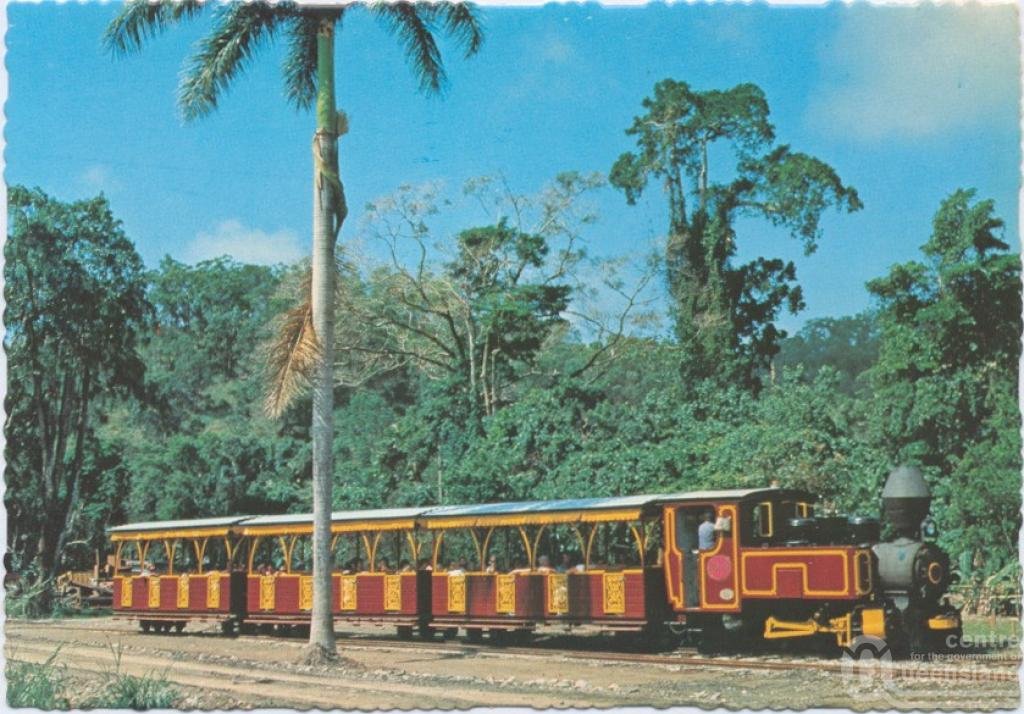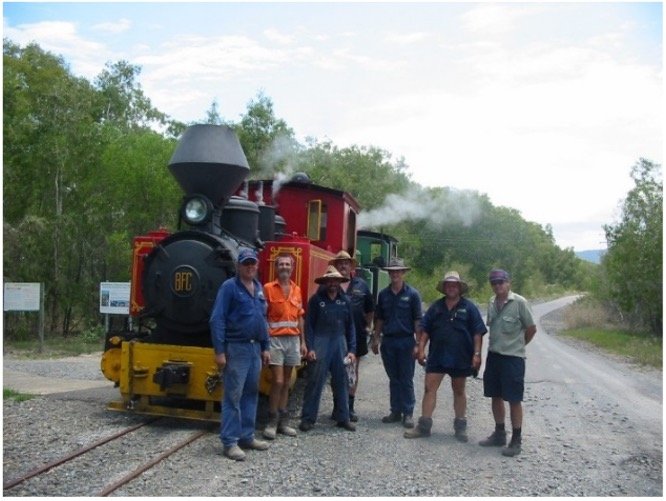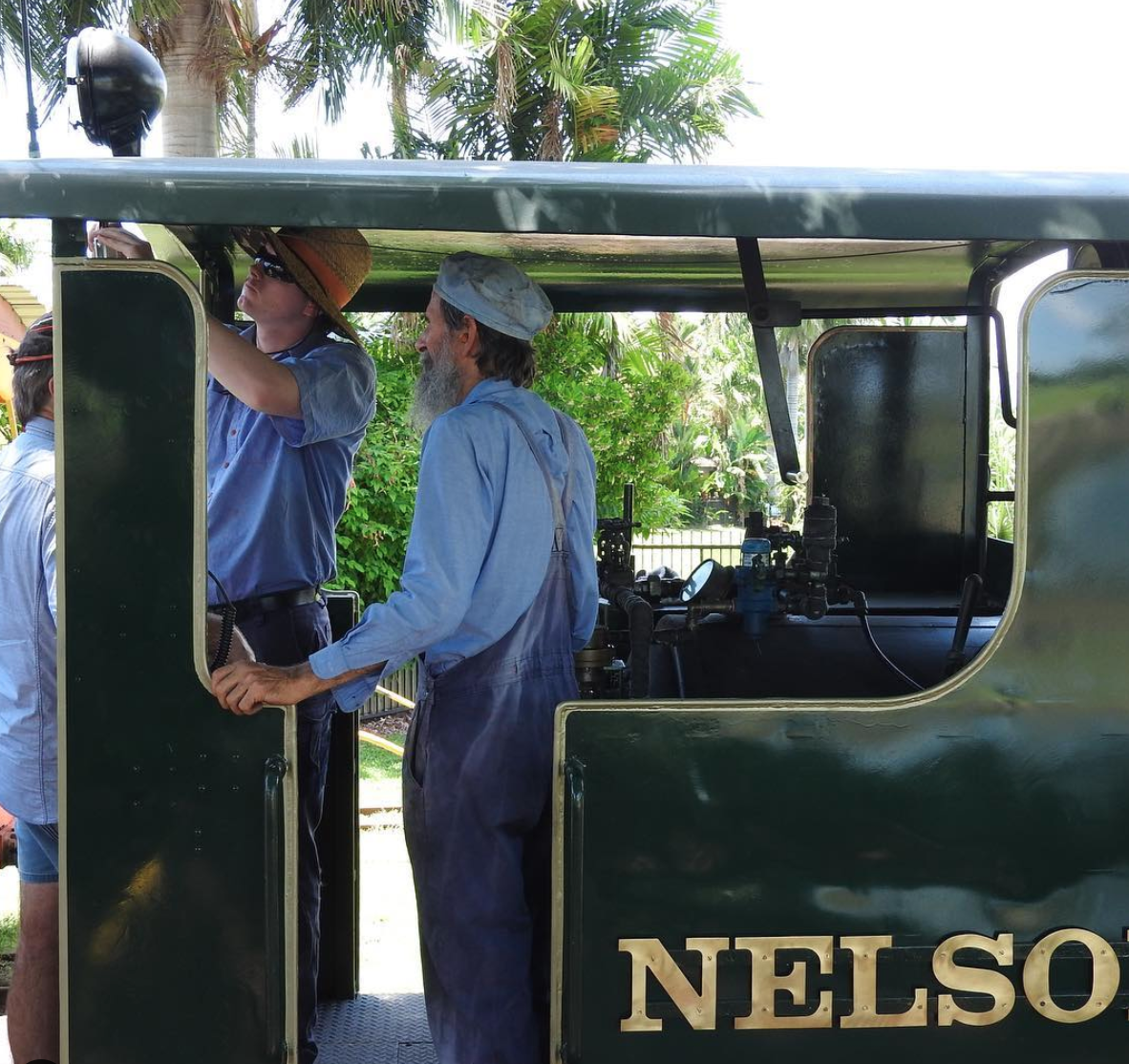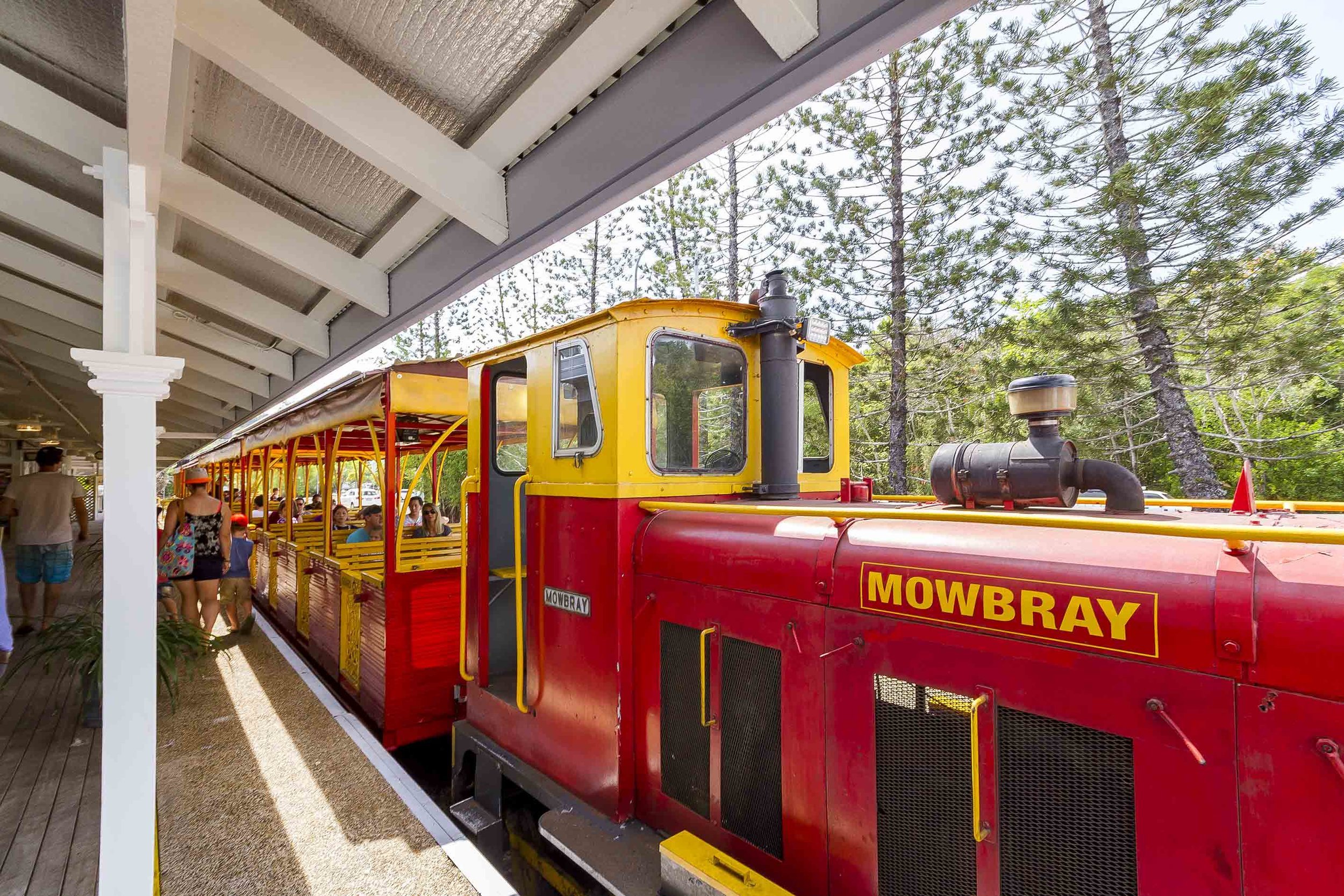History of the Bally Hooley Railway
The Hudswell Clarke locomotive hauling the Ballyhooley Steam Express on its tourist run.
Mossman is the most northerly sugar mill in Australia. Sugar was first grown in the area in the 1880s. With the help of Government capital local farmers were able to build their own mill and, on 23 August 1897, Mossman Central Mill Company Ltd commenced crushing and bagged sugar was sent to Cairns by sea for export. A tramway was built to take the sugar to the wharf in Port Douglas. The trains also carried passengers and freight.
In 1979 Mossman Central Mill conducted a feasibility study and decided to take advantage of a developing tourism industry in the shire establishing a small tropical orchard in the mill grounds. For the first time, tourists were encouraged to visit the mill, free guided tours were provided, the cost offset by the sale of souvenir items specific to the industry and to Mossman. It was not particularly profitable, but the main payoff was the exposure of the public to reliable information about the industry.
Building on its initial success, the company embarked on building a tourist centre, converting the Ranch, which provided meals for staff, workers and locals, into a station complete with an operating steam locomotive and tourist train.
A Bundaberg Fowler steam locomotive, Dobbin, was purchased from Qunaba Mill, and renamed Ballyhooley, after a settlement in Mowbray valley at the bottom of the Bump Track. Four passenger carriages running on canetainer frames and bogies were built by J. Lewry of Port Douglas. Meeting legal requirements and obtaining the necessary public liability cover proved the most lengthy part of the operation. The tourist train began running on 24th August 1981, giving tourists a wide variety of views including the mill, the town from Mill Street, the rainforest beside the South Mossman River, and the canefields and harvesting on its run to the Newell Beach terminus.
Spike Jones (J Bailey photo)
John Ziegler at the controls and Robbie Walker (J Bailey photo)
Following its initial success, the Bally Hooley Stream Express commenced the 1982 season with an official gala opening, presided over by the Minister for Tourism, Mr Tony Elliott, on 3rd May 1982 as part of a Labour Day public holiday ‘Fun Run Day’ event raising money for local organisations with runners racing the train to Newell Beach Golf Course. This fun run was held annually for a number of years, a runner winning some years and the Ballyhooley others.
During the year the Ballyhooley Stream Express attracted 11,000 passengers. After three years, patronage exceeded I000 in one week of the school holidays.
About the same time a train trip to Port Douglas as far as St. Crispins was started. However, this was not really successful as the tourists thought a tour of the Mill and the trip to Newell Beach was better value for their money.
Things started to change in the 1980's. The opening of Cairns as an international airport in 1984 laid the foundation for rapid tourism development of the whole region. Christopher Skase and his company, Qintex Ltd, moved into Port Douglas building the Sheraton Mirage Resort, which opened in 1988, and the Marina. The Radisson Royal Palms and other developments in tourism quickly followed.
Recognising this development in the tourism economy, Mossman Mill moved their single men's barracks over to the Marina and undertook a restoration converting it into the Marina Railway Station, where tours terminated, and established Douglas Developments Pty Ltd as a subsidiary to operate the Bally Hooley. This enabled the tramway to provide a commuter service to parts of Port Douglas, as well as operating mill tours to Mossman. Tourists had the choice of a half-day tour to the mill or a full day including an outing to Drumsara, a sugar cane farm at the foot of Mount Demi. The company also continued to operate the Newell Beach run. Three locos were used - Bundy and Speedy were both Fowler built locomotives, and Sydney, a Hudswell Clarke locomotive, was purchased from Hambledon Mill in 1987. (There is no train called Bally Hooley-that was the name given for the collection of locomotives).
From the early 1900s, narrow gauge (2 ft, 610 mm). railway line tracks from the Mill into Port Douglas were used for freight, passengers and hauling freshly cut cane from the Mill to the aptly named Sugar Wharf (because there were other wharves along the waterfront). When Mossman Mill stopped transporting sugar into Port Douglas in 1958, part of the rail line was pulled up but was re-laid by the Mill 30 years later in 1987 as part of the Ballyhooley venture.
The old line had taken the train through town. The new track was laid down from near what became known as the Country Club station, down the back road past the Cemetery, through the mangroves and along the waterfront through to the Marina Railway Station. The Mill now ran tours from the Mill to the Marina once a week and St Crispins to the Marina daily during the crushing season.
In 1995, after reviewing the risks from level crossing and train accidents, and the effect on its main business, Mossman Central Mill decided to no longer operate the tourist trains or mill tours and ceased train operations except for the Port Douglas commuter service.
In early 2000, the steam locomotives Speedy and Bundy were relocated to Port Douglas from Mossman and the Mill continued to operate the Ballyhooley Steam Railway until late 2002. Over time the distance of the train trip was shortened to approximately 4 kms within the Port Douglas area, and for a number of years, the service was run on Sundays only, by a group of enthusiastic volunteers.
The steam loco Speedy was built in Bundaberg in 1952 and commissioned to the Millaquin Mill near Bundaberg. In 1978 it was sold to Qunaba Mill and renamed Dobbin. Dobbin was purchased by Mossman Mill in 1981 and renamed Speedy and was also used in the Bally Hooley tourism train operation.
Steam locomotive Bundy (0-6-2 Tank engine) was commissioned new for the Mossman Central Mill in 1952 and was built at the Bundaberg foundry. In 1971 the locomotive was sold to a train enthusiast and Bundy went to Melbourne. In 1977 the owner sold the train and it returned to Bundaberg where it was privately owned but was being repaired by apprentices at the East Bundaberg TAFE. It was repurchased partially repaired by Mossman Mill in 1988 and used to pull the Ballyhooley tourist train between Port Douglas and Mossman.
Port Douglas and Mossman Gazette, 3 July 2003
It was then purchased privately by John Morris and family, a long-time local developer who purchased the rolling stock and tracks and began a serious upgrade of all hardware with a view to re-establishing the operation. This commenced in March 2003 but shut down briefly in July 2003 because of the high running costs, particularly insurance and labour. However, after numerous meetings with various interested parties, and with strong support from the group of local volunteer train buffs, the steam train recommenced operating on weekends and public holidays in late 2003. It continued until 2016 when a change was made to run on multiple days per week as a tour and commuter service during the busy tourist season.
Local volunteers kept the trains running for the enjoyment of the community.
The Bally Hooley Steam Train enjoyed excellent patronage, including from many local families who became regular train travellers. Numerous enquiries were made for weddings while other groups chartered the train for functions, school groups, fun runs etc. Over 18,000 passengers travelled during the 2007 year and In September alone, nearly 3000 passengers travelled on just nine operating days.
Mowbray (0-6-0 Diesel M), built by Baguley in 1954, was the first diesel locomotive to join the fleet of 4 steam locos to haul cane in the district and began hauling cane in Mossman that year.
The problem in turning the engine in a confined space was solved by the purchase of turntable surplus from Queensland Railways. The turntables were installed at both ends of the line to turn the locos.
Another locomotive, Nelson, built in 1934, was purchased by John Morris from the Mulgrave Mill. All the rail line and rolling stock had served its life in the cane industry and had now been refurbished to excellent condition. Any operating shortfalls were covered by John Morris’s company, The Port Douglas Steam Train Company.
In 2008, while the train continued to operate, urgent capital works and maintenance was required on some sections of the historic line. The scope of the work was beyond the capability of the Port Douglas Steam Train Company or its volunteer workforce. The Douglas Shire Historical Society was asked to support an application to the EPA “Living Building and Places Heritage Grant Program” to fund urgent maintenance upgrades to the rail track to enable the Bally Hooley Steam Train to continue operating. At the time the Mossman Mill commented "The steam train is an integral part of the agricultural and community history of the Douglas Shire and we hope that this history, through the Bally Hooley Steam Train operations, continues to be brought to life for current and future generations.”
In about 2017 the diesel loco, Mowbray, was first used for the tourist train, running Monday to Saturday. However this was not what people wanted, although the Sundays were still very popular when the steam train was running.
A trip on the Bally Hooley, with stations located at Crystalbrook Super Yacht Marina (originally the Reef Marina), QT Resort, Sheraton Grand Country Club and St Crispins took about an hour.
An excerpt from the Bally Hooley web page in 2019 describes the train trip:
“Departing Crystalbrook Superyacht Marina the leisurely hour journey starts with a panoramic view over the harbour and its collection of sailing charter boats, luxurious superyachts, pleasure craft and trawlers. The train passes through the tropical mangroves nestled behind the busy streets of Port Douglas. The service is staffed by a dedicated team of railway enthusiasts, who love sharing its story, and provide commentary on local history, ecology and culture along the way. After a quick stop at the Sheraton Grand Country Club and at QT Resort, the train heads on towards the St Crispins Station where a vibrant lakeside Choo Choos cafe is located. Here, while the locomotive is un-coupled, and prepared for the return journey, brunch, a refreshing drink or an ice cream at Choo Choos Café can be enjoyed.
Then it’s “All Aboard” for your return journey to the Marina.
Choo Choos at the Marina is located at the end of the Crystalbrook Superyacht Marina. The waterfront cafe was the perfect place to get a coffee or enjoy breakfast or lunch before or after your train journey!”
Then COVID-19 hit and the train has not run since October 2019. A sign on the Bally Hooley Rail Tours web page reads, “We are currently not operating the train due to the Covid-19 pandemic. A re-opening date is yet to be determined. Sorry for any inconvenience.”
Postscript
A New Life for the Bally Hooley Trains
(Excerpt from Newsport Daily Port Douglas News Release 24/8/2021 )
The much-loved Bally Hooley steam trains that have been a part of the Douglas Shire since 1897 are taking on a new life that will share the remarkable part they have played in the region’s history with a new generation of locals and visitors. They are about to become a very trendy – yet traditional – dining experience at the Marina Station.
Purchased from Mossman Mill in 2002, the John Morris family have owned and maintained the trains, as well as the tracks with a core team including a dedicated group of volunteers allowing it to operate over many years in Port Douglas between the Marina and St Crispins.
At 93, John Morris has been keen to ensure that these historic trains remain forever within the shire, and over the last couple of years, has sought in vain to find a committed group to continue its operation. Approaches were made to several organisations, including the Douglas Community Sports Club, Historical Society and the Douglas Shire Council, but none were able to commit to the long-term future of the trains.
Unable to operate over the last 18 months due to Covid, the trains have been stored and maintained at the depot. During this time a new vision emerged, one that would ensure they remain in the Douglas Shire in the future. With the help of designer Sofia Goncalves, plus artisan carpenters and builders Peter and Frank Goncalves, the trains have been quietly undergoing a transformation that reflects both their history and creates a whole new way to take a step back in time. Some of the earliest photographs of the trains in action will be on display, dating back before 1900. Over the coming months the tracks will be removed by Mossman mill and put to use in the cane carting operation.
The restoration crew, from left to right: Frank Goncalves, John Morris, Peter Goncalves and Sofia Goncalves
By late September, steam engines Speedy and Nelson will have completed their transformation allowing for everyone to be able to access and experience the operating controls in a safe way. Along with totally refurbished carriages, they will be relocated to their new home at the Marina Station, surrounded by newly created native tropical gardens. With lead lighting windows, iron ware, tables and seating that will reflect a bygone era, the Douglas Shire will provide an entirely new historical dining experience.
Facebook Post 29/9/21
This morning around 10.30 am Nelson & Speedy got their last steam up to run along the track from the work shed to the Crystalbrook Marina, Port Douglas. The engines and a refurbished carriage will be permanent fixtures at Choo Choos' Restaurant. Images below / Bally Hooley Choo Choos at the Marina Station Oct 2021 (G Cockburn photos)
2022/ The original tracks have now been removed.
Bundy at Choo Choos, St Crispin’s Station before joining Nelson and Speedy at the Crystalbrook Superyacht Marina.
This article has been provided by Gail Cockburn with Peter Lloyd of the Douglas Shire Historical Society (NQ) Inc in 2021.
References /
Peter Lloyd, former Mossman Central Mill employee, Volunteer Operator/Engine driver/ Ballyhooley Steam Train 2008-2015
Kerr, John: Northern Outpost (Mossman Central Mill), Chapter 17 - pp 161-164. Second edition 1995. Copyright ©1995 Mossman Central Mill Company Limited
The Bally Hooley Steam Train Line Heritage. Excerpt from a submission to “Living Building and Places Heritage Grant Program” seeking financial assistance for urgent capital works and maintenance required on some sections of the historic line to keep it running
https://www.ballyhooleyrail.com.au/about-bally-hooley
https://www.portdouglastravel.com/region-guide/things-to-do/tours-activities/bally-hooley---heritage-steam-train-trip---port-douglas.526.html
Historical Notes: Mossman District/Mossman Central Mill from the Ted Ward Collection
CTN_13: Historical Notes: Mossman Copyright © September 2011
CaneSIG: http://www.zelmeroz.com/canesig

